- Bernard Preston homepage
- Compost
Starting a compost pile
Starting a compost pile is hard physical work and not for the faint-hearted; your own humus is without equal. There is an alternative; turn them into permanent raised beds.
Nature retains the fertility of the earth by returning all dead plant and animal material to the soil. It is decomposed to humus by bacteria, microbes and earthworms. It is an entirely ordinary process but it can be hastened by starting a compost pile; millipedes, snails and a billion tiny creepy-crawlies are to be found there too.
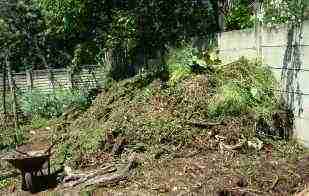
You can also add bokashi; these are bacteria that further enhance the fermentation. I am currently experimenting with that and will report in due course.
The autumn leaves, fallen rotting branches and kitchen-waste suddenly are no longer irritating garbage; they become a valuable resource is the search for food that both tastes and is better than what you can buy commercially.
Just the unbelievable rich flavour of freshly-picked veggies makes this an exercise worth considering. You can also cancel your gym contract unless you're training for the Winter Olympics!
This page was last updated by Bernard Preston on 8th July, 2024.
If you are serious about the earth and love gardening, there are few more rewarding pastimes than starting your own compost piles. They lie at the heart of tasty organic-vegetables.
Not unimportant is that the compost heap tidies up the grass cuttings, fallen leaves and small twigs; dry branches and kitchen waste too that you would otherwise have to transport to the dump. It is one small helper in the race to end waste.
Conventional agricultural methods will return nitrogen, potassium and phosphate to the soil but the host of micronutrients soon becomes deficient; and so of course the food grown is also short of selenium, zinc and a thousand other substances needed to sustain optimal wellness of both the plants and the humans who eats them.
You either have to take a bushel of different supplements or get busy with starting a compost pile.
Science of composting
There is a whole science of good composting; however this is one of those processes that even done badly will be incredibly rewarding. The worst that can happen is that it will take a little longer to produce the fine humus you desire; or even stink a bit if it becomes compacted or water-logged.
Frankly building your own relatively large compost pile will be a lot more rewarding and less costly than the multitude of bins, turners and so forth that cost a fortune; and produce only a few bucketfuls of decent humus.
In the graphic above you can see where I have been tidying up old broccoli, Brussel sprouts and rocket plants. They are bolting with the advent of summer; they make perfect composting material.
Surprisingly a blooming compost heap, one where aerobic respiration is happening, has no foul odour at all.
It is the anaerobes that stink. Your pile needs plenty of air.
Composting encourages microbiological activity in the ground, improves water retention and the soil structure. It contains most of a plant's requirements, feeding the earth and producing nutritious crops.
Most of the work of composting is done by a host of micro-organisms that thrive in warm and moist conditions; and very importantly, an aerated environment. Compacted heaps may stink.
Your compost heaps needs to be moist for your vast army of micro-organisms to flourish but a waterlogged pile will tend to be anaerobic.
You will probably periodically have heavy rains so, to improve the drainage at the base, I like to place some old rotting logs beneath the first layers of coarse material to allow the water to run freely away.
Manure
I like to toss in a bag or two of truly organic cow or horse manure that I collect whilst gliding; during the week the cattle are allowed to roam on the aerodrome. This is Africa.
The rough material once the hens have
finished with it is also rich in their droppings and is perfect when
starting a compost pile. I do not buy in chicken manure; there is great risk of salmonella bacteria, antibiotics and all sorts of undesirables from a commercial flock.
To build a compost heap you have to use a bit of science; and some folklore.
When starting a compost pile like that above, I always begin with thick stems such as from old maize plants, ginger and hydrangea prunings that you are clearing at the end of the season. Coarse straw from stables would be perfect too but it may have been treated with Roundup, so I now avoid it; or old rotting logs.
Really all this is just about getting your garden soil ready for your seeds and young plants.
At the end of the dry season compost heaps in late winter need to be uncovered and the dark-brown gold harvested.
Starting a compost pile
Starting a compost pile with all the nutritional benefits for your plants and self-satisfaction of growing and enjoying organic foods cannot be overstated. Just see the huge but sweet butternut that we turn for months in winter into delicious soup. Really it is part of working with nature, rather than against it. What scientists are now calling backyard permaculture.
If you want normal cholesterol without statins and much less chance of metastatic and heart disease, then start thinking of your own garden; with none of the toxic chemicals that now proliferate on the planet's farms where your food is grown.
It is also after recycling, the next step of operation end waste.
It all starts in the kitchen where you need the right container; read more about it at compost bins for gardening.
Then on top of this base you can pile all your grass cuttings, kitchen waste and the mountains of leaves that every garden produces. Do not send them to the dump; making a compost pile is the solution.
Take large sheets of cardboard but remove any plastic; soak them in water overnight, tear into strips and add it to the heap. It allows for the movement of air and helps to reduce carbon from the atmosphere.
Research shows that increased carbon dioxide in the air is having a very detrimental effect on protein (down 10 percent) and minerals like iron and zinc in our food.(1)
Old logs make the perfect foundation for your compost pile.
Define humus for a better understanding of what is going on in your compost pile.
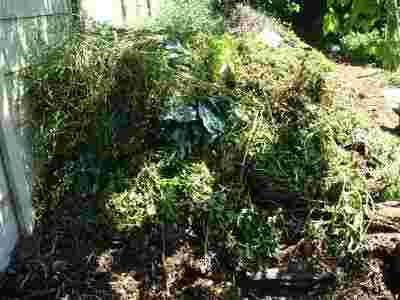
A couple layers of chicken, horse or cow manure adds nitrogen and speeds up the process of composting. When active aerobic fermentation is happening, the pile can actually get quite hot.
In very cold weather you might want to cover your compost pile with a layer of soil, dead leaves or cardboard to keep it warm.
When we returned from our seven-year sojourn in the Netherlands, our garden was smothered by a leafy ground cover, commonly known as Wandering Jew. Despite the fears of friends and family, I have found that it makes perfect compost material, breaking down completely to form a thick, dark humus.
Weeds from the garden can be used too but it is often best to let them dry out and die first; and not if they have seeded. The heat in the compost pile may kill some of the them.
It is often said that you cannot utilise orange peels for the heap but I have tried using the left overs of making our own juice; it does take longer to decompose them than the rest of the pile. The humus has a beautiful, gentle scent of citrus; it is lovely.
Prime compost is dark brown, almost black having the sweet, clean smell of the earth.
It is generally hard work; easy composting may be helpful.
Cutworms
I am unsure but I do think that compost can provide a good environment for cutworms that may attack your young plants to flourish, so I have taken to digging a trench, and covering the compost with 6" of earth. That seems to sort them out.
Alternatively, spread the compost, and turn it a few times before planting. Recently we have been then allowing the hens to check it out; they peck through the pile. They love cutworms.
Best of all, I have recently built a movable chicken tractor; there are many designs. Placing it over new compost, before planting, ensures there are no unfriendly cutworms left in the soil.
The long and the short of it is that starting a compost pile is not without a few hiccups.
This is an update; the hens have really provided the solution to three invaders in our garden; snails, cutworms and the Mexican bean beetle that completely nailed our string beans for three years in a row. It is all part of the synergy of green living.
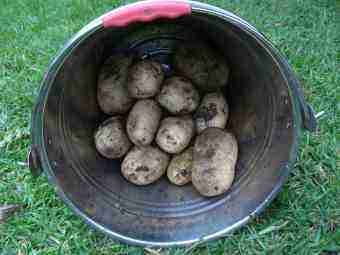
Just look at these organic spuds; 12 large potatoes from just one plant. Best of all is lifting them with your grandchild. It turns a chore into a treasure hunt.
Incidentally new potatoes have much less of a glycemic effect than those from cold-storage; read, they are less fattening and do not cause a surge in blood glucose.
Earthworms
Earthworms love a compost heap, and their droppings do wonders for your humus. It is a good idea when working in the garden, should you find any collect them and drop them on the pile. They will multiply ten-fold, and you will return far more to mother Earth than you took out.
Earthworms and starting a compost pile remain central to our thoughts on the ten commandments of food security; and whether it is sustainable or not.
One way to dramatically increase the number of earthworms in the garden is the use of your autumn leaves. There really should be no discussion about whether to compost or mulch; both are important.
Fetida
The wonder of worm farms
I have only recently discovered; if you have a problem with the world's
greatest invader specie, the brown rat, then do not put your kitchen
waste into the compost pile, but into your fetida farm. It must have a lid.
They complement your own earthworms. When starting a compost pile you need all the living creatures you can find, but not rats, to break down the kitchen and garden waste.
What is fetida, and what is a worm farm you may be asking?
They are the worms that are credited, rightly or wrongly, with cleaning up the cesspool of human garbage that created the environment for the Black Plague in the Middle Ages.
Having been starting a compost pile, and keeping fetida worm farms for years now, I am glad to report that the wrigglies are to be found throughout our heaps of vegetable matter, but not in the soil; they are not an invader species, as far as I can tell. In any event they get cleaned up by our free range hens.
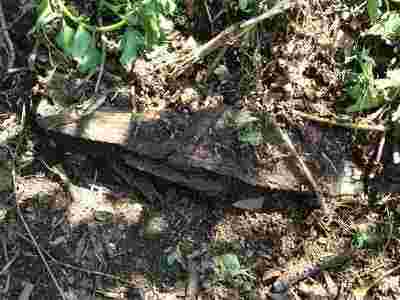
Growing green beans
Growing green beans is really not difficult. All you need is a stake, pole, fence, or rose trellis, but I made the latticework below because we like to eat green beans every day in the summer to reduce our reliance on red meat and dairy for protein.
Your growing green beans, bush or pole, are heavy feeders and starting a compost pile means a much larger and tastier crop.
Plus because of nitrogen fixation bacteria on the roots of all legumes, the next crop will take off.
Newsletter
Our newsletter is entitled "create a cyan zone" at your home, preserving both yourself and Mother Earth for future generations; and the family too, of course. We promise not to spam you with daily emails promoting various products. You may get an occasional nudge to buy one of my books.
Here are the back issues.
- Lifestyle and ideal body weight
- What are ultra-processed foods?
- Investing in long-term health
- Diseases from plastic exposure
- Intensive lifestyle management for obesity has limited value
- A world largely devoid of Parkinson's Disease
- The impact of friendly bacteria in the tum on the prevention of cancer
- There's a hole in the bucket
- Everyone is talking about weight loss drugs
- Pull the sweet tooth
- If you suffer from heartburn plant a susu
- Refined maize meal and stunting
- Should agriculture and industry get priority for water and electricity?
- Nature is calling
- Mill your own flour
- Bake your own sourdough bread
- Microplastics from our water
- Alternative types of water storage
- Wear your clothes out
- Comfort foods
- Create a bee-friendly environment
- Go to bed slightly hungry
- Keep bees
- Blue zone folk are religious
- Reduce plastic waste
- Family is important
- What can go in compost?
- Grow broad beans for longevity
- Harvest and store sunshine
- Blue zone exercise
- Harvest and store your rainwater
- Create a cyan zone at your home
There are few more rewarding vegetables in the garden than pole beans. The bush variety have a shorter growing season, but picking them will break your back and, if you allow the chooks out of the chicken tractor design they will go straight for the green beans in the garden; they too need the protein.
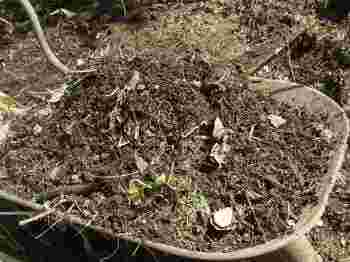
“Balanced food for the soil yields nutritious for you.”
- Frank van Steensel
Plus beans are full of phytosterols, the stuff that protects against neoplasms and cholesterol; those chickens know what is good for them. Picked fresh from the garden and blanched lightly they are simply delicious. It is a hugely winning situation.
Into each hole at the base of these bamboo stakes you will place a good shovelful once you have been starting a compost pile. Really it is not difficult, it takes 3 to 4 months to make perfectly decomposed humus. It is so very rewarding if you are serious about gardening.
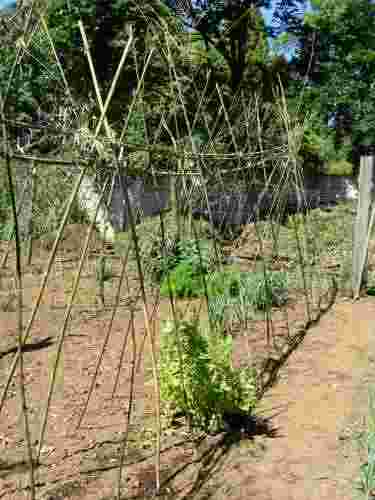
Another legume certainly worth considering is the broad bean; I will not pretend it is my favourite, but it is amazing what the tongue can be taught at least to tolerate. I mean, fifty years ago I would not even consider a green salad; now I love it.
By the same token each year, harvested young and with imaginative cooking, favas as they are called in Europe have become a staple winter protein in our family.
One big plus is that how to plant broad beans is really very easy. The coarse leaves, stems and roots are perfect at the end of the season when starting a compost pile; they are full of nitrogen-forming bacteria. The teepee above is suitable for staking. I will do a page on that elsewhere; you need twine to keep them up, otherwise they flop over with the weight of the fruit.
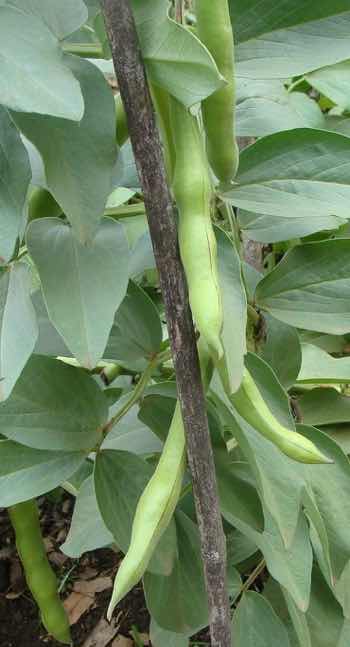
“There is no waste in the way we farm; we do not use any fertilisers."
- Josje Neerincx
Phytochemical foods
Phytochemical foods are vastly beneficial, yet science still does not understand a tenth of what they do; starting a compost pile will enrich your backyard vegetables and fruit.
These plant nutrients make up the thousands of substances in natural foods that have a beneficial but often unproven effect on our wellbeing. Many of them give vegetables their bright colours. Others, like lignans in seeds, have profound anti-cholesterol properties; and help prevent breast disease. But it all begins with starting a compost heap.
They make your eyes blink when peeling onions and your mouth water when you see a bowl of fresh strawberries; they are the fragrance in sweet basil that is to die for. They are also the fatty acids in many oils.
And people who eat them have less neoplasms, heart disease and lower blood pressure; reduced breast and prostate disease. The sky is the limit. They are the reason why the good wife and I, both in our mid-seventies take absolutely no medication.
They are better absorbed if eaten with a little fat; dribble olive oil over your salads, an avocado or a good dollop of hummus.
If you are a gardener, even on a small scale, starting a compost pile is where it all begins if you want to grow nutritious, great-tasting veggies.
Hens
Hens just love it when you are starting a compost pile; it is Christmas with a feast of worms and other tiny creatures for dinner laying in wait in the future.
Previously we banned the hens from the compost heap; the creepie-crawlies were too precious but since the advent of the worm farm we have a surplus, and the ladies are welcome to join me when I turn the pile.
I open the chicken tractor door and they dive into the garden.
Best chicken feed includes access to the compost pile.
It is also the best solution to the question can you feed eggshells to hens? Toss them into the compost pile for the birds, having processed them slightly.
Just look at their excitement at that beautiful rich black compost on the left of this picture; their droppings contribute to it.
Tomorrow by the barrowload, I will be moving it to where we will be planting the winter vegetable garden; broccoli, broad beans and spring onions. Lettuce, cabbages and kings all must be well-established before night temperatures drop and the soil becomes too cold for germination. There will be a feast in a couple months for us too.
We are always looking for a surplus; gifts for friends and patients. Educating them on the virtues of wellness is part of the deal; this year I am going to try the surplus broad beans on the hens too instead of laying mash. Alas it did not work; not all experiments and ideas are successful.
It is all part of a process known as permaculture; creating a stable environment and hoping to leave a habitable planet behind for our grandchildren. No-till helps keep carbon in the soil and removing it from the atmosphere.
We take it a step further now, where we combine the virtues of both being greenies and challenged by the Blue Zones of the world where living into strong old age is the norm.
What is a cyan zone? That is the colour, more often called turquoise, that is a mixture of blue and green.
It will be rich in plant protein, tumour-preventing kaempferol and a host of other phytochemicals. This is the stuff that keeps Dr Death at bay; for a season. I am looking forward to an extra twenty good years of sparkling wellbeing, sitting under those trees we once planted, sipping tea and watch the grandkids grow up.
Is it to be believed that the good wife are in our eighth-decade, and take no medication? Let your food be your medicine.
The hens, worms and compost piles all help in the race to end waste; over one-third of the food produced for humans is never actually eaten. These creatures will enjoy all your left overs, in the process fertilizing your garden.
Chickens in the garden have created a whole new dimension to our backyard permaculture.
Turn compost heaps into raised garden beds for long-term improvement.
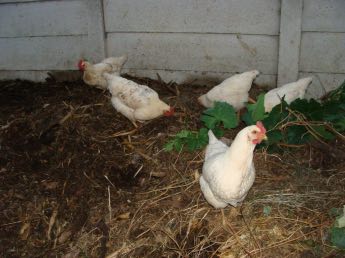
USEFUL LINKS
Making a compost pile is for those more interested in what is actually going on; about aerobic vs anaerobic composting. There something profound going on inside that pile.
Compost heaps in late winter is the time to harvest the black gold.
When browsing use right click and "Open Link in New Tab" or you may get a bad gateway signal.
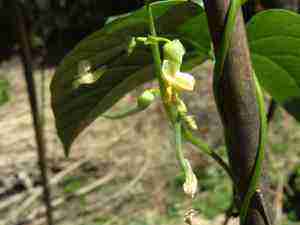
Bernard Preston
Bernard Preston is also a writer, busy with his seventh book to be published hopefully late in 2024. Have you read any of the others? If you are enjoying this site, you will love Doc Bernie's humour; find them in the navigation bar above. When he is not writing, he is either starting a compost pile, or working the hens and worm farms; or tinkering with his solar generator.
Can you imagine the sense of achievement of driving a car that uses no fossil fuels with a battery entirely charged from the sun? Helen is a very happy lady. Most of the time she is in the garden helping create a Blue Zone, where ten times as many folk live to 100; or giving lessons in Mathematics.
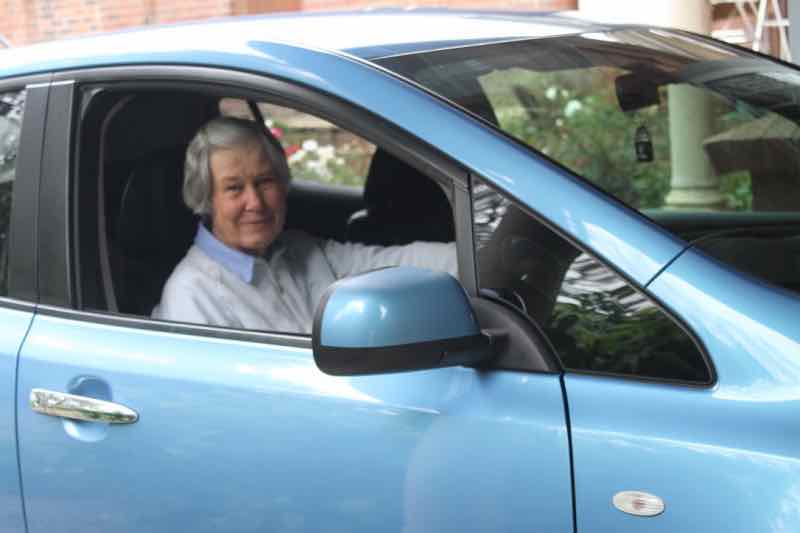
Did you find this page interesting? How about forwarding it to a friendly book or food junkie? Better still, a social media tick would help.
- Bernard Preston homepage
- Compost
Address:
56 Groenekloof Rd,
Hilton, KZN
South Africa
Website:
https://www.bernard-preston.com